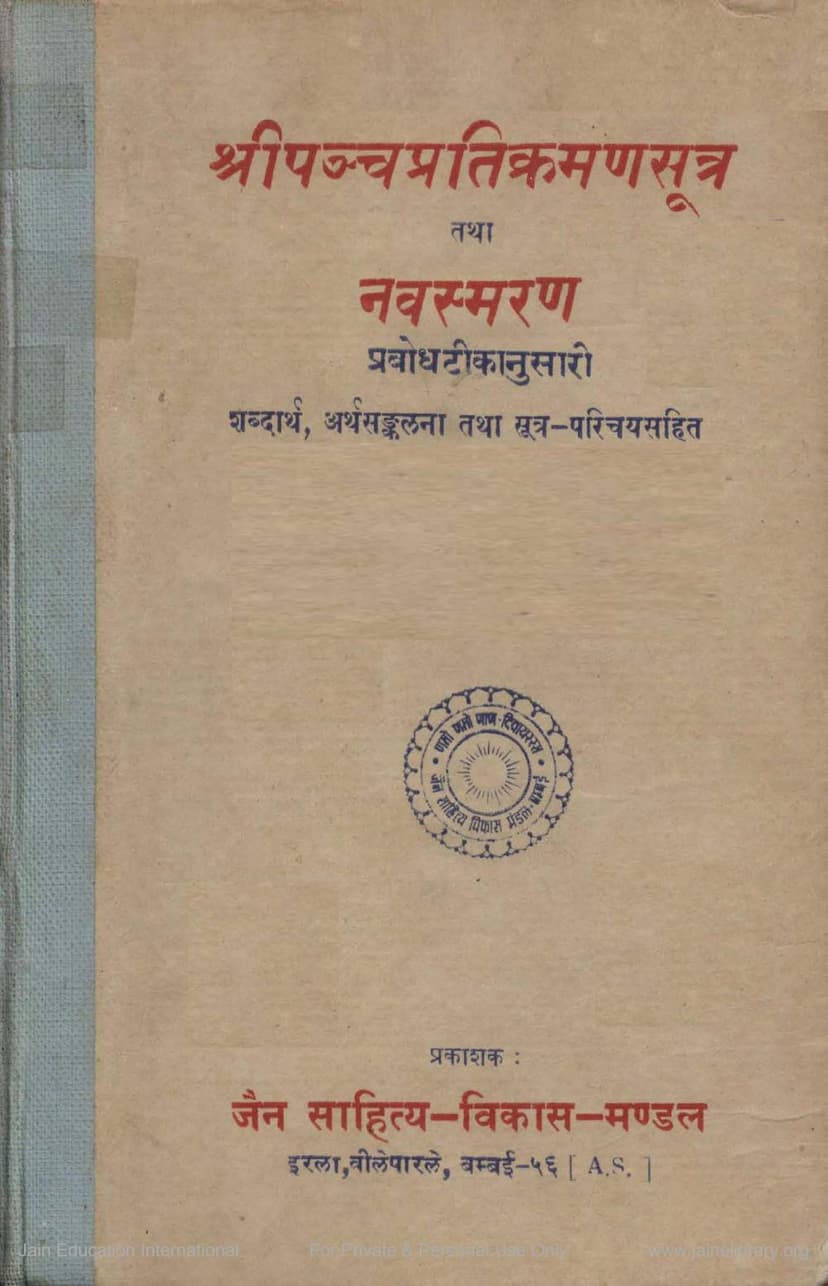Panchpratikramansutra Tatha Navsmaran
Added to library: September 2, 2025

Summary
This document is a comprehensive guide to Jain religious practices, specifically focusing on Panch-Pratikraman-Sutra and Nav-Smaran (Five Repentance Sutras and Nine Recitations). Published by the Jain Sahitya Vikas Mandal, Mumbai, this book, in its second edition, aims to provide readers with a detailed understanding of these important Jain texts.
Here's a breakdown of its key aspects:
Core Content:
- Panch-Pratikraman-Sutra (Five Repentance Sutras): This section is the primary focus. It details the various types of Pratikraman (repentance rituals) essential for spiritual purification in Jainism. The book elaborates on:
- Routine Pratikramans: Daily (Daivasik), Nightly (Rātrik), Fortnightly (Pākshik), Four-monthly (Chāturmāsik), and Yearly (Sānvatsarik) Pratikramans.
- The ritualistic procedures and their underlying reasons.
- Nav-Smaran (Nine Recitations): This part covers nine auspicious recitations that are important for Jain spiritual practice.
- Supporting Prayers and Hymns: The book includes a vast collection of devotional prayers, hymns, and stotras dedicated to the Tirthankaras and other revered figures in Jainism. These include:
- Various stutis (praise songs) and stavans (devotional songs).
- Aarti (lamps for worship).
- Mangal-Deepak (auspicious lamps).
- Twoartis and two auspicious lamps.
- Specific couplets for auspicious occasions like praying before the deity or circumambulating sacred sites.
- Navaang Pooja (worship of nine divine limbs).
- Ashta-Prakari Pooja (worship with eight items).
- Four prayers to the Prabhu (Lord), sixteen Chaitya-vandans (worship of shrines), twenty-five stavans, fifteen stutis, five sajhay (devotional songs), six chhandas (metrical compositions) and pada (verses), and two aartis.
- Fourteen rules for lay followers (Shravaks) and seventeen types of cleansing rituals (Pramārjanā).
Structure and Features:
- Detailed Explanations: Each sutra is presented with its original name and its commonly used name in brackets. The text includes the original script, a word-by-word meaning (Shabdarth), and a compiled meaning (Arth-Sankalana).
- Sutra-Parichaya (Sutra Introduction): This section provides context about when and why a particular sutra is recited, along with relevant traditions and legends.
- Question-Answer Format: To clarify the concepts, some sections include a simple question-and-answer format.
- Methodologies: The book clearly explains the procedures for commencing and concluding Samayik (meditative practice), Chaitya-vandan, various types of Pratikraman, Posadh (fasting), sneezing etiquette, and breaking fasts (Pachchakkhan Parane).
- Inclusion of Gujarati and Hindi: The text acknowledges the inclusion of Gujarati Atichar (transgressions) followed by Hindi Atichar and Nav-Smaran, which were not present in the first edition.
- Comprehensive Collection: Beyond the core texts, it offers a wide array of auxiliary devotional content, including prayers for various deities, invocations, and rules of conduct for lay followers.
- Corrections and Revisions: The publication mentions that the second edition has incorporated corrections for errors found in the first edition.
Publisher and Author:
- Publisher: Jain Sahitya Vikas Mandal, Vile Parle, Mumbai.
- Author: The text itself doesn't explicitly name individual authors for each sutra but attributes the compiled work to the knowledge base referenced by the "Prabodh Teeka" and the publishing entity, Jain Sahitya Vikas Mandal.
Overall Purpose:
The book is designed as a practical guide for Jain followers to perform their religious duties with understanding and devotion. It aims to preserve and disseminate the knowledge of these crucial Jain scriptures, enabling individuals to connect with their faith on a deeper level. The emphasis on detailed explanations and traditional context makes it a valuable resource for both learning and practice.